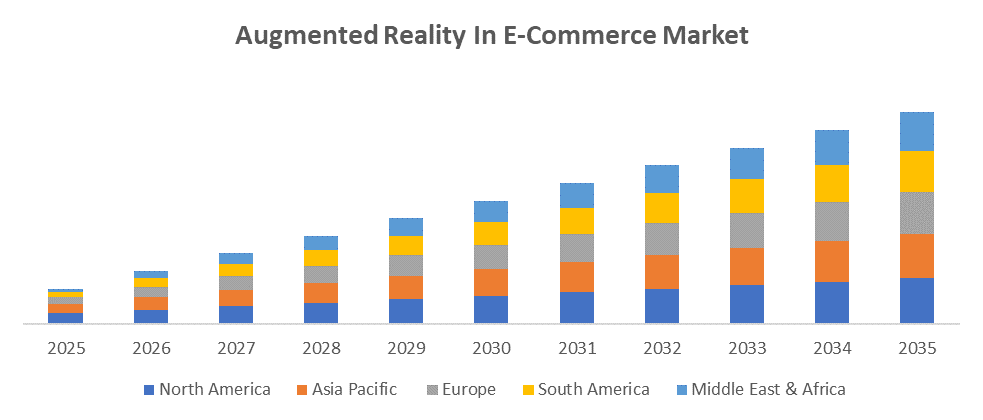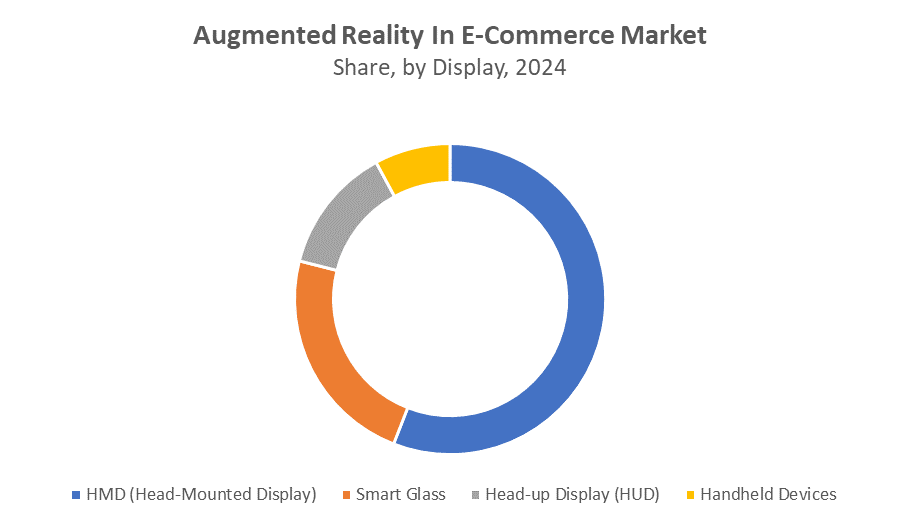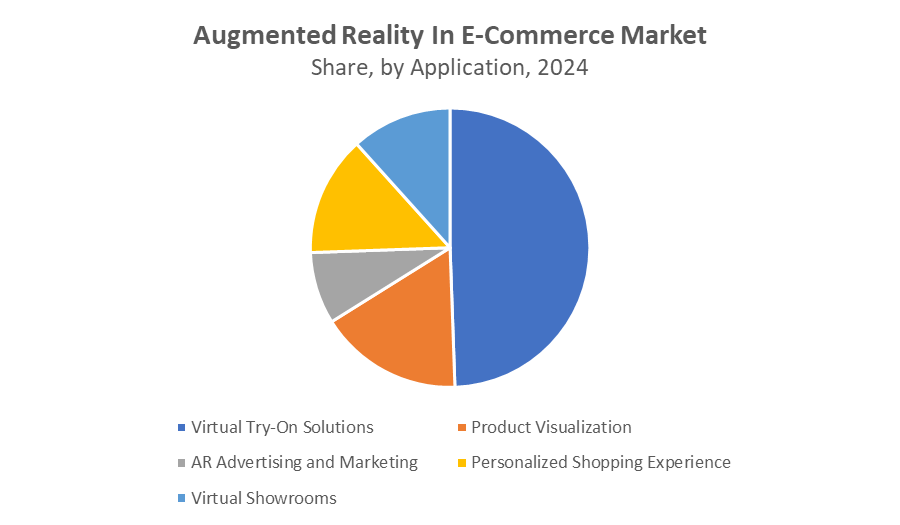Global Augmented Reality In E-Commerce Market Size, Share, and COVID-19 Impact Analysis, Russia-Ukraine War Impact, Tariff Analysis, By Component (Hardware, Software), By Display (HMD (Head-Mounted Display), Smart Glass, Head-up Display (HUD), Handheld Devices), By Application, and By Region (North America, Europe, Asia-Pacific, Latin America, Middle East, and Africa), Analysis and Forecast 2025 - 2035.
Industry: Information & TechnologyAugmented Reality In E-Commerce Market Summary
According to Spherical Insights, The Global Augmented Reality In E-Commerce Market Size is Expected to Grow from USD 5,872.4 Million in 2024 to USD 16,7842.9 Million by 2035, at a CAGR of 35.63% during the forecast period 2025-2035. A key driver of AR in e-commerce is the rising demand for immersive, interactive shopping experiences.
Key Market Insights
- North America is expected to account for the largest share during the forecast period
- In terms of segment, the hardware segment is expected to dominate the market over the forecast period
- In terms of segment, the head-mounted display (HMD) segment accounted for the largest market share in 2024
- In terms of segment, the virtual try-on solutions segment accounted for the highest revenue in 2024

Get more details on this report -
Augmented Reality In E-Commerce Market
The augmented reality in e-commerce market leverages AR technology to enhance online shopping by allowing customers to visualize products in real-world settings before purchase. This innovation improves user experience, boosts customer engagement, and reduces return rates. Key driving factors include increasing smartphone penetration, rising consumer demand for immersive shopping, and advancements in AR software and hardware. A notable recent development is Apple's launch of the Vision Pro mixed-reality headset in 2024, offering high-resolution displays and advanced gesture controls, which enhances AR shopping experiences. Governments worldwide are supporting the adoption of AR through initiatives that promote digital innovation and smart retail solutions, such as funding for tech startups and creating favorable regulatory frameworks. These combined efforts are accelerating market growth by making AR more accessible and practical for retailers and consumers alike.
Trends
- Increased adoption of AR-enabled mobile apps to offer interactive product visualization on smartphones.
- Integration of AR with AI for personalized and enhanced shopping experiences.
- Growth of AR try-on features in fashion and beauty sectors, allowing virtual fitting of clothes and makeup.
- Expansion of AR in furniture and home decor to help customers visualize products in their living spaces.
- Rising investment from major tech companies and startups to develop innovative AR retail solutions.
Augmented Reality In E-Commerce Market Dynamics
Global Augmented Reality In E-Commerce Market Report Coverage
| Report Coverage | Details |
|---|---|
| Base Year: | 2024 |
| Market Size in 2024: | USD 5,872.4 Million |
| Forecast Period: | 2025-2035 |
| Forecast Period CAGR 2025-2035 : | 35.63% |
| 2035 Value Projection: | USD 16,7842.9 Million |
| Historical Data for: | 2020-2023 |
| No. of Pages: | 240 |
| Tables, Charts & Figures: | 100 |
| Segments covered: | By Component, By Display, By Application and By Region |
| Companies covered:: | Google LLC, Apple Inc., Microsoft Corporation, Amazon.com, Inc., Samsung Electronics Co., Ltd., PTC Inc., Shopify Inc., Zugara, Inc., Magic Leap, Inc., Wikitude GmbH, and Others |
| Pitfalls & Challenges: | COVID-19 Impact, Challenges, Future, Growth, & Analysis |
Get more details on this report -
Driving Factors: Widespread adoption of smartphones and improvements in AR hardware and software
Key driving factors for the augmented reality in e-commerce market include the increasing demand for immersive and interactive shopping experiences that help customers visualize products in real time, reducing purchase hesitation and return rates. The widespread adoption of smartphones and improvements in AR hardware and software make the technology more accessible to consumers. Additionally, the shift toward online shopping, accelerated by the COVID-19 pandemic, has pushed retailers to adopt AR to enhance customer engagement. Growing investments by major tech companies and supportive government initiatives promoting digital innovation further drive the market’s rapid growth and adoption worldwide.
Restrain Factors: High development and implementation costs
Major restraining factors for the augmented reality in e-commerce market include high development and implementation costs, which can be challenging for small and medium-sized retailers. Limited AR content and lack of standardization across platforms also hinder seamless user experiences. Additionally, technical issues like device compatibility and bandwidth requirements may affect performance. Privacy concerns related to data collection in AR applications, along with consumer hesitation to adopt new technology, further slow market growth despite its potential benefits.
Opportunity: Growing smartphone penetration and improvements in 5G connectivity enable smoother
Growing smartphone penetration and improvements in 5G connectivity enable smoother, high-quality AR experiences for a wider audience. Expansion into new sectors such as automotive, real estate, and healthcare opens fresh applications beyond traditional retail. The integration of AR with artificial intelligence offers personalized shopping experiences, increasing customer satisfaction and loyalty. Additionally, rising demand for contactless shopping solutions post-pandemic encourages retailers to adopt AR to enhance safety and convenience. Collaboration between tech firms and retailers also fosters innovation, creating opportunities for new product launches and market expansion globally.
Challenges: Limited consumer awareness and reluctance to adopt new technology
Technical issues like device compatibility and varying internet speeds can affect user experience. Additionally, the lack of standardized AR content and consumer privacy concerns around data usage pose barriers. Finally, limited consumer awareness and reluctance to adopt new technology slow widespread market acceptance despite its benefits.
Global Augmented Reality In E-Commerce Market Ecosystem Analysis
The global augmented reality in e-commerce market is rapidly growing, driven by advancements in AR technology and shifting consumer preferences. Key players like IBM, Microsoft, Google, Amazon, and Apple develop AR platforms, while startups innovate niche solutions. Core technologies include machine learning, computer vision, and natural language processing. AR enhances customer experience by enabling interactive product visualization and virtual try-ons. North America leads the market, with Asia Pacific showing the fastest growth. This dynamic ecosystem fosters continuous innovation and wider adoption across retail and related sectors.
Component
The hardware segment dominates the global AR in e-commerce market because devices like smart glasses, AR headsets, and smartphones are crucial for immersive shopping experiences. These devices let users visualize products in real time, improving purchase confidence and reducing returns. Advances in sensors, cameras, and displays have boosted AR quality and usability. Additionally, the growing availability and affordability of smartphones worldwide drive demand for AR hardware in e-commerce applications.
The software segment is expected to witness significant CAGR during the forecast period due to growing demand for advanced AR applications and platforms that enable seamless product visualization and interaction. Continuous improvements in AR software, including better image recognition, AI integration, and user-friendly interfaces, are driving adoption. Additionally, increasing investments in AR development tools and cloud-based solutions are helping retailers offer personalized and scalable AR experiences, boosting the software segment’s growth in the e-commerce market.
Display
The head-mounted display (HMD) segment accounted for the largest market share in the global AR in e-commerce market in 2024 due to its ability to provide immersive, hands-free augmented reality experiences. HMDs offer high-quality visuals and real-time interaction, making them ideal for virtual try-ons and product demonstrations. Their growing adoption in retail and increasing technological advancements have boosted their popularity, helping enhance customer engagement and satisfaction in online shopping environments.

Get more details on this report -
The smart glass segment is expected to witness the highest CAGR in the global augmented reality in e-commerce market during the forecast period due to its lightweight design, portability, and hands-free functionality. These features make smart glasses ideal for seamless AR experiences, such as virtual try-ons and real-time product visualization. Advances in smart glass technology, along with growing consumer interest and increasing adoption in retail, are driving rapid growth in this segment.
Application
The virtual try-on solutions segment accounted for the largest market share of the global augmented reality in e-commerce market in 2024 because it enables customers to virtually test products like clothing, accessories, and cosmetics before purchasing. This technology enhances customer confidence, reduces return rates, and improves the overall shopping experience. Its popularity is driven by increasing consumer demand for personalized and interactive online shopping, making virtual try-on a key application of AR in e-commerce.
The personalized shopping experience segment is expected to witness the highest CAGR in the global augmented reality in e-commerce market during the forecast period due to growing consumer demand for tailored and immersive shopping journeys. AR technologies enable retailers to offer customized product recommendations, virtual fittings, and interactive features that enhance engagement and satisfaction. Advances in AI integration with AR further boost personalization, driving rapid adoption and growth in this segment.
North America is anticipated to hold the largest market share of the augmented reality in e-commerce market during the forecast period, due to its advanced technological infrastructure, high smartphone penetration, and strong presence of key AR technology providers. Additionally, early adoption by major retailers and continuous investments in AR innovation drive the region’s market growth. Consumer demand for enhanced online shopping experiences further supports North America’s leadership in the AR e-commerce space.

Get more details on this report -
Asia Pacific is expected to grow at the fastest CAGR in the augmented reality in e-commerce market during the forecast period, due to rapid digitalization, increasing smartphone adoption, and expanding e-commerce penetration. Growing investments in AR technology by local startups and tech companies, along with rising consumer demand for immersive shopping experiences, are fueling market growth. Additionally, supportive government initiatives promoting innovation and smart retail solutions contribute to the region’s accelerated adoption of AR in e-commerce.
Key Market Players
KEY PLAYERS IN THE AUGMENTED REALITY IN E-COMMERCE MARKET INCLUDE
- Google LLC
- Apple Inc.
- Microsoft Corporation
- Amazon.com, Inc.
- Samsung Electronics Co., Ltd.
- PTC Inc.
- Shopify Inc.
- Zugara, Inc.
- Magic Leap, Inc.
- Wikitude GmbH
- Others
Recent Development
- In September 2024, Snap Inc. unveiled its fifth-generation Spectacles, a pair of standalone AR smart glasses featuring a 46° stereo display, hand-tracking, voice control, on-device Snap OS, and Lenses for immersive AR interactions, marking a notable leap in wearable AR tech
Market Segment
This study forecasts revenue at global, regional, and country levels from 2020 to 2035. Spherical Insights has segmented the augmented reality in e-commerce market based on the below-mentioned segments:

Get more details on this report -
Global Augmented Reality In E-Commerce Market, By Component
- Hardware
- Software
Global Augmented Reality In E-Commerce Market, By Display
- HMD (Head-Mounted Display)
- Smart Glass
- Head-up Display (HUD)
- Handheld Devices
Global Augmented Reality In E-Commerce Market, By Application
- Virtual Try-On Solutions
- Product Visualization
- AR Advertising and Marketing
- Personalized Shopping Experience
- Virtual Showrooms
Global Augmented Reality In E-Commerce Market, By Regional Analysis
- North America
- US
- Canada
- Mexico
- Europe
- Germany
- UK
- France
- Italy
- Spain
- Russia
- Rest of Europe
- Asia Pacific
- China
- Japan
- India
- South Korea
- Australia
- Rest of Asia Pacific
- South America
- Brazil
- Argentina
- Rest of South America
- Middle East & Africa
- UAE
- Saudi Arabia
- Qatar
- South Africa
- Rest of the Middle East & Africa
Frequently Asked Questions (FAQ)
-
1. What is the projected market size of the Global AR in E-Commerce Market?According to Spherical Insights, the market is expected to grow from USD 5,872.4 million in 2024 to USD 167,842.9 million by 2035, registering a CAGR of 35.63% during the forecast period (2025–2035).
-
2. Which display segment is expected to grow fastest in the forecast periodSmart Glasses are projected to witness the highest CAGR due to their lightweight, portable, and hands-free design ideal for retail and personal use.
-
3. Why is the hardware segment currently dominating the AR in e-commerce market?Hardware such as smartphones, AR glasses, and HMDs is essential for delivering AR experiences. The proliferation of affordable, high-performance mobile devices globally enables broader access to AR, giving hardware a foundational role in the ecosystem’s current growth phase.
-
4. What are the major challenges facing the AR in e-commerce market?• High development and implementation costs • Limited AR content and lack of standardization • Device compatibility issues and internet bandwidth requirements • Consumer privacy concerns and limited awareness
-
5. Which display technology holds the largest market share in 2024?The Head-Mounted Display (HMD) segment held the largest share in 2024 due to its immersive, hands-free AR experience for virtual try-ons and demonstrations.
Need help to buy this report?